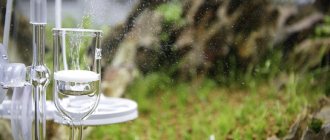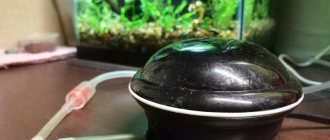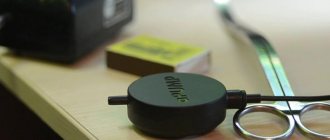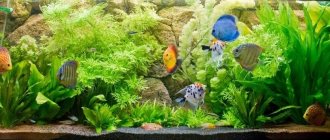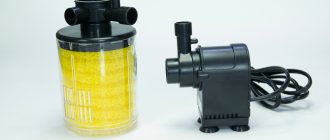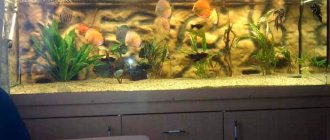An aquarium skimmer has other names: foam skimmer, skimmer and skimmer. Because of this, there can sometimes be misunderstandings about what is being said. A skimmer is a device necessary for a marine aquarium, which is an integral part of the filtering system of the aquatic world . This device removes from the water products that are released during the metabolic process and do not settle out sufficiently to be removed from the aquarium by other cleaning systems. A high-quality device removes up to 80% of organic compounds from water, including protein.
Skimmers for aquariums - what are they?
The skimmer, also called a skimmer or skimmer, is the main filtering device of a marine aquarium. The word is of English origin: the verb skim is translated as “remove the top layer”, respectively, skimmer is a “skimmer”. Other names for the filter device are protein skimmer, foam separator column.
Aquarium skimmer
Aquarist's blog Aqua-As
Hello, Dear readers of the aquarist’s blog Aqua-As, I offer you a short review of the internal skimmer (aka foam skimmer, flotator) for a marine aquarium MACRO AQUA model NS 16. The foam skimmer is supposed to be used in a 140 liter aquarium without a sump.
Technical characteristics of the skimmer MACRO AQUA NS 16
- Designed for aquariums with a volume of 80-160 liters
- Skimmer size 270*80*80 mm
- Pump power 8 W
There were positive reviews on the forums about the Resun Sk-300 Nano Needle skimmers; the MACRO AQUA NS 16 skimmer is very similar in design.
Here are the technical characteristics of the Resun Sk-300 Nano Needle skimmer:
- Designed for aquariums up to 95 liters
- Skimmer size 220*90*50
- Pump power 3.5 W
Here is a comparison photo of the Resun Sk-300 Nano Needle skimmer.
The MACRO AQUA NS 16 skimmer is planned to be used on an aquarium without a sump with a volume of 130 liters, which this foam should pull, based on the characteristics declared to the manufacturers.
Here are some photos of the MACRO AQUA NS 16 skimmer.
The plastic from which the MACRO AQUA NS 16 Skimmer is made is not bad, everything is done very carefully. I tested the skimmer in an aquarium and I’ll immediately note that I didn’t like it. The first moment, part of the air bubbles, leaks through the junction of the two halves of the body, without getting into the chamber and higher into the foam collection bowl.
I disassembled the case, reassembled it, it became better, but it is not a fact that the component halves of the case will not separate again.
The second point is that the skimmer is mounted on suction cups and with the help of a special bracket-holder; to be honest, it doesn’t hold very securely; when adjusted, it constantly slides off; it’s a pity, of course, that it wasn’t made on magnetic holders.
Well, in general, this is so, first impressions, the skimmer is not yet permanently installed, then as this unit is used, I will write about it in this review. Also, for clarity, the video shows how the MACRO AQUA NS 16 skimmer works in a 130 liter aquarium.
Several months have passed since the use of the MACRO AQUA NS 16 skimmer; in principle, I am completely satisfied with the performance of this skimmer; it copes with its functions very well. Earlier I wrote that air bubbles leaked through the case, or rather through the joint of the two halves of the case, over time it went away, somehow by itself, I didn’t do anything to the case, I didn’t insulate it or glue it.
The next point, the fastening of the skimmer (suction cup) initially did not seem very reliable, but nevertheless it holds well. The foamer works very confidently, even despite the “wandering” water level in the aquarium (there is no sump and no automatic top-up is installed), accordingly the level constantly fluctuates, which does not affect the operation of the skimmer in any way.
The only thing is that the cup, of course, is of a very modest size; it fills up completely within a day, although on the other hand, a large cup would look bulky; after all, this foam bowl is intended for small aquariums.
In general, it seems to me a good choice for reasonable money. You can read in more detail about the development of an aquarium where this foam is used in the article My simple marine aquarium.
Source: https://akwa-as.ru/skimmer-dlya-akvariuma-macro-aqua-ns-16/
What are they intended for?
An aquarium is a closed and, as a rule, densely populated system. Various organic residues gradually accumulate in it - plant remains, feed, excrement, etc. All this rots, which ultimately leads to the release of ammonia - an extremely dangerous toxic substance that provokes poisoning of the inhabitants. When the alkalinity of water increases, the concentration of ammonia also increases. And vice versa.
A skimmer is used to reduce protein
On a note ! It is for this reason that skimmers are usually not used in freshwater aquariums, where the pH level averages 6.5-7.5. There is enough of a good filter there - biological or chemical. While in marine aquariums (pH 8.2-8.3) you cannot do without it.
Sump for a marine aquarium
So, what are aquarium skimmers for:
- reducing algae ;
- removal of phosphates and proteins;
- Collection of dirt and organic matter through bubble cleaning.
This mechanism is used to suppress the amount of algae
Description of equipment
The skimmer, or skimmer and skimmer as it is also called, is one of the main filtering devices in a saltwater aquarium. In a closed biological system, organic matter, protein, and other contaminants will invariably accumulate, which can be destructive for fish and corals. It will be simply impossible to do without using this device in a marine aquarium where there is a high pH level.
Foam in an aquarium is necessary for:
- removal of dirt and organic matter;
- removal of phosphates and proteins;
- suppression of algae growth.
Most skimmers use bubble cleaning technology, when tiny bubbles are supplied inside the device body through a compressor, adsorbing dirt, phosphates and proteins, thereby ensuring high-quality cleaning of the aquarium. It is possible to use a skimmer for a freshwater aquarium, where such equipment allows you to remove ammonia and nitrates from the water. It is only necessary to correctly determine the power of the pump depending on the volume of the aquarium.
This mechanism is used to suppress the amount of algae
The operating principle of an aquarium skimmer is extremely simple. Many, while at sea, noticed abundant dirty foam near the running line. This foam, which is formed from the churning of water by the surf, contains organic matter and other contaminants. A skimmer uses a similar operating principle. Inside the glass or plastic cylinder there is a powerful air compressor and a special impeller, which allows you to obtain the smallest air bubbles .
The smaller the air bubbles knocked out, the better the cleaning. Air bubbles carry along protein molecules, organic suspensions and other contaminants. Subsequently, such dirt is removed from the aquarium in the form of a bad-smelling slurry.
How the skimmer works
Have you ever seen a seashore during a strong wind? Have you observed how the foam that formed due to the churning of organic matter, air and water is nailed? The skimmer has the same operating principle . with ozone rise up a cylinder filled with water . These bubbles carry proteins and organic suspensions with them, turning them into foam and removing them from the reservoir into special foam collectors. In the latter, all this settles in the form of “coffee” slurry.
Floater operation diagram
What is a skimmer used for?
Any aquarium is a closed system, the processes in which occur in a special way. Most often, a significant overpopulation is observed in a home pond, since the aquarist wants to see several species of fish in it at once.
Organic residues are not absorbed in the aquarium, as is the case in the wild, and gradually accumulate. Their main source is excrement left by pets, excess food that went unnoticed and not removed from the water, dying plant fragments and dead fish and shellfish. If the water is not cleared of organic matter in a timely manner, its excess can lead to a sharp increase in the level of ammonia in a home pond, which poses a danger to fish.
The foam resulting from the operation of the skimmer is collected in a special container.
The inhabitants of a freshwater aquarium are quite easy to maintain, and to maintain their normal condition, cleaning the tank once a week with replacing ¼ of the volume of water is enough for them. This is not enough for saltwater fish, and you cannot set up a marine aquarium without equipping it with a skimmer.
The device allows you to remove organic compounds and various contaminants through bubble cleaning, when foam is formed, which is collected in a special container and removed from it regularly.
An aquarium foam bottle works on the principle of sea surf, in which water is churned to form foam filled with organic compounds . In the cylinder of the device, after it is filled with water, small air bubbles pass through, which can sometimes be supplemented with ozone.
Diagram of the operation of an aquarium foam tank.
Advantages and disadvantages
Flotators have their own strengths and weaknesses; let’s take a closer look at them.
Pros and cons of an aquarium skimmer
Benefits of a skimmer
- removing most of the contaminants before they begin to decompose (read: preventing water poisoning);
- maintaining the required acidity ;
- reducing the load on filters;
- increase in redox potential.
Disadvantages of a skimmer
- because of its work, part of the microplankton , and it is not only a source of nutrition, but also a useful part of the ecosystem;
- reduction in salinity level (a concentrated salt solution is removed along with the foam). This moment needs to be controlled by adding not fresh, but sea water;
- extraction of useful substances needed by corals (microelements, vitamins, amino acids);
- a decrease in the effectiveness of some drugs due to the fact that the surfactants included in their composition are removed.
This equipment has a number of disadvantages
Adjustment and Settings
The effectiveness of using skimmers in a marine aquarium will largely depend on how correctly the pump power and type of equipment are selected for the volume and specific population of the biosystem. Today, most manufacturers make various models of skimmers that are designed for a particular aquarium volume, which greatly simplifies the choice.
Depending on how the flotator is used, it can be configured for dry or wet foam. When set to wet foam, the device will operate at maximum efficiency, and the aquarist will have to add additional trace elements and live plankton to the water on a regular basis. When set to work on dry foam, the skimmer can work at half its power, knocking out only protein and other contaminants from the water.
Setting the operation of the device for dry or wet foam can be done by adjusting the supply of air mixture to the pump. Most devices allow you to reduce or increase the air supply intensity; accordingly, it is possible to fine-tune the operation of the foam separator, depending on the load on the biosystem. You can also adjust the skimmer by changing the level of foam in the reactor, for which the device is raised or immersed deeper in the sump or aquarium.
Maintenance of skimmers is not particularly difficult, and such work should be performed on a regular basis. The aquarist will need to empty the foam container every two weeks, clean and replace the spray nozzles. The frequency of such maintenance will depend on the intensity of feeding of corals and fish, the workload of the aquarium and the presence of other equipment in it. The foam container is cleaned on a regular basis, and once a month the foam container is removed from the sump and completely washed.
Types of skimmers for aquariums
Among such devices there are simple and affordable models that operate from a compressor and are intended for aquariums with a volume of up to 300 liters. Large containers require a more powerful foam tank with an injector and a pressure pump, or, alternatively, several simple ones. Powerful skimmers are installed in a special compartment with a constant water level - sump.
There are 3 most popular types of skimmers
Table. What types of foam separators are there for aquariums?
| Name, photo | Short description |
| Direct flow | Simple and ineffective devices that can only be used in small aquariums. Installed inside the tank. Compressed air is supplied by the compressor to the contact chamber through a sprayer. Numerous small bubbles rise, mix with water and form foam. Clean water comes out through a hole in the top, and the foam is fed into the foam container. |
| Countercurrent | A more complex version of direct flow. The water in them moves from top to bottom, towards the air bubbles. Counter flows have a lower speed, which means the air stays in contact with water longer and more effective cleaning is performed. “Advanced” models are installed outside the aquarium; they are a cylinder into which air is supplied from a sprayer from below, and water is pumped from above by a pump. |
| With Venturi nozzles | Much more effective and more complex than the options described above. The service life is practically unlimited and the skimmers do not require maintenance. The flow of water is created by a pump. The operating principle is similar to a car carburetor. The water flows through a tapering tube with a tiny hole at the end. The pressure in it first increases, and at the outlet it drops sharply. When it falls, air is sucked in through a hole in the side wall of the tube. The result is a kind of air-water “cocktail”, which is fed to the lower part of the foam separating column. |
Note that experienced aquarists use ozone, not ordinary air . This ensures maximum skimmer efficiency; In addition, it also oxidizes organic matter and sterilizes water. , activated carbon must be present at the air and water outlets .
Charcoal for aquarium
Important ! When using ozone, you need to be extremely careful: it negatively affects the human respiratory system, causing chronic diseases.
Experienced aquarists use not just air, but ozone
What to look for when choosing a device
When purchasing a device, you need to carefully select it. You shouldn't buy the first skimmer you come across. Experts who professionally deal with aquariums recommend paying attention to a number of features of the model when purchasing a device.
- Easy to clean foam container. Dirt will get into it every day, and it is advisable to remove it immediately. If disassembling the unit is quite difficult, then it will be inconvenient. All parts of the skimmer must be easy to install and at the same time have reliable connections that will not leak.
- Ease of hand penetration into the filter. Its complete cleaning with washing of the inner walls will be required at least once every 6 months, and ideally more often.
- Accessibility for cleaning the pump that creates the air flow. If necessary, you must be able to quickly clean the working part of the unit.
When choosing a skimmer, pay attention to its size, manufacturer and ease of use.
You need to choose a device that is manufactured by a well-known, reputable company that provides a guarantee for its products. It should also be possible to buy spare parts for equipment if necessary. If there are none, then the slightest breakdown will be the reason for purchasing the foam again.
TOP 5 best skimmers (flotators, skimmers) for an aquarium
Let's take a look at the rating of the best skimmer models that are currently popular.
Table. TOP 5 best aquarium skimmers.
| Name, photo | Short description |
| Resun SK-300 | · dimensions – 150x150x480 mm; · aquarium volume – up to 300-500 l; · power – 13 W; · productivity – 300 l/hour; · Manufacturer – Resun (China). |
| Aqua Medic power flotor L | · dimensions – 85x45x215 mm; · aquarium volume – up to 90 l; · power – 3.5 W; · installed in sump; · Manufacturer – Aqua Medic (Germany). |
| HYDOR SLIM-SKIM NANO 135.35 | · dimensions – 80x85x300 mm; · aquarium volume – up to 250 l; · power – 4 W; · installed on glass (hinged); · manufacturer – HYDOR (Italy). |
| Aqua Medic EVO 1000 | · dimensions – 250x110x460 mm; · aquarium volume – up to 500 l; · power – 9 W; · installed in a sump, mounted on glass; · Manufacturer – Aqua Medic (Germany). |
| EHEIM skimmarine 600 | · dimensions – 525x190x190 mm; · aquarium volume – up to 600 l; · power – 19-40 W; · installed in sump; · Manufacturer – Eheim (Germany). |
Video - Skimmers for aquariums
Making an injector for a pump
The essence of the injector is that we need to narrow the hole at the pump inlet and cut in the air supply tube at the point of its expansion; a vacuum will form in this place, which will suck in air.
For this we need a polypropylene coupling and a piece of thick-walled pipe. We solder the pipe into the coupling on one side and cut it flush. At the expansion point we install a piece of tube for a 4mm hose.
The pump is ready, now skeptics (like me) can start testing. For these purposes, you can use a 3-5 liter eggplant.
You shouldn’t count on results right away, since foaming will begin no earlier than in a day, or even more, until the inner surface is covered with a bacterial film.
And the result more than satisfied me, because in one day, such a makeshift machine knocked out more skimming than two of my pneumatic foams in a week.
How to set up a skimmer?
More complex devices can be adjusted depending on the desired result.
- Wet foam . In this case, the device, operating at full capacity, knocks everything out of the water as much as possible - the aquarium may be left without plankton , which is undesirable.
- Dry foam . Obviously, here the skimmer will work to a minimum.
- Intermediate results.
What exactly can be configured:
- adjusting the supply of air mixture to the pump;
- change in foam level in the reactor. To do this, you need to immerse deeper or raise the skimmer in the sump relative to the surface of the water;
- see the previous paragraph, but the outlet from the skimmer is closed with a damper or tap.
Foam for aquarium
Common types of skimmers
Today, several types of skimmers have become widespread, differing in their operating principle and purpose. Some models operate from an external compressor and are designed for aquariums with a capacity of no more than 300 liters. Popular options are those that should be installed in a sump located under the aquarium and having a constant water level.
The most common types of foam separators today are:
- Straight-through. The simplest modifications of skimmers, which are intended for installation in a small aquarium. This type of equipment has a contact chamber into which compressed air is supplied through a compressor. The smallest bubbles in the chamber rise, mix with water, after which a thick foam forms on the surface, which is directed into a small foam collector.
- Counterflow skimmers are a more complicated version with water supplied from top to bottom. The speed of counter flows of air and water is lower here; therefore, the direct contact of the smallest bubbles and water lasts longer, which increases the productivity of such equipment. Depending on their size, counterflow skimmers can be installed both inside the aquarium and in the sump, where water is supplied using a separate pump.
- With Venturi nozzle. This is the most effective and at the same time complex device, which includes a water pump and a special compressor. The presence of Venturi nozzles with needle valves allows the air to be broken into the smallest dust, which ensures the highest possible efficiency of the use of skimmers. Skimmers built on Venturi nozzles can be installed exclusively in a sump, where a stable water level is constantly maintained.
A properly selected foam filter will allow you to replace the filter, relieving the aquarist of the need for frequent water changes. This reduces salt consumption, which reduces the cost of maintaining a reef aquarium.
There are 3 most popular types of skimmers
Rules of service
There is nothing complicated in servicing skimmers; follow a few simple rules.
- Sprayers need to be cleaned and replaced regularly . Moreover, the frequency will depend on the intensity and frequency of feeding of the inhabitants, on the workload of the aquarium, on the operation of other equipment (filter, for example).
- The foam container also needs regular cleaning . What may be required both daily and once a month - it all depends on the type of skimmer and the size of the aquarium. Constantly monitor the amount of foam formed.
Skimmer maintenance
Also read : Soil for an aquarium - which one is better to choose. In addition, you will probably be interested in an article about the TOP 20 most beautiful aquarium fish.
Features of device maintenance
Maintenance of the device is not difficult. High-quality devices require minimal attention from the owner. Caring for this special filter comes down to timely cleaning, changing the nozzle and washing the foam collector. How often these procedures need to be performed depends on the conditions under which the fish are kept, the volume of the tank and its population.
The quality of water in the aquarium is determined by how quickly the foam container fills. If filling occurs very quickly, it is worth cleaning the tank and changing the water.
How to make a skimmer with your own hands
High-quality branded skimmers are very expensive, so not every domestic aquarist can afford them. But many people make foam separators with their own hands , which can significantly reduce costs. Moreover, if a home-made device is assembled correctly, then in terms of efficiency and performance it will not be much inferior to expensive factory-made devices!
DIY skimmer
To make a skimmer at home, you will need:
- return pump (sufficiently powerful);
- waterproof sealant;
- aquarium compressor;
- plastic pipes, fittings for them;
- container (glass or plastic);
- plastic fitting to connect containers.
Aquarium compressor
Step 1 . First of all, containers made of glass or plastic are glued together with sealant. If there is an intermediate partition, it needs to be drilled or cut off. The result is a transparent skimmer column - part of it will be under water.
Step 2 . In the third container, which has a smaller diameter, a hole is drilled or cut with a construction knife, the diameter of which is slightly smaller than that of the plastic tube used. In the future, it is important to take care of a tight fit of the pipes and tightness inside the container.
Step 3 . The intake tube is made so that it tapers towards the entrance to the skimmer column.
Step 4 . The joints are thoroughly lubricated with sealant and then dried.
Step 5 . The compressor and pump are connected separately, and the smallest bubbles should be obtained - as they rise up the column, they adsorb contaminants and discharge them into the foam collector.
Follow the instructions for assembling the foam
On a note ! To upgrade your homemade skimmer, you can use needle sprayers. Moreover, it is possible to provide separated drainage and water intake into the column.
As you can see, skimmers for an aquarium can be made with your own hands without any problems. You just need to choose the right pump and compressor in terms of power, and also use high-quality polypropylene tubes and plastic containers. The most popular are homemade skimmers designed for installation inside a sump. Such devices may have increased sizes and unsightly appearance, but they are highly effective, providing high-quality water purification from various types of contaminants.
Marine Aquarium Configuration Example
You can also use the recommendations given in the video to make a skimmer.
Video - Simple skimmer for a marine aquarium
Self-production
A skimmer is an expensive purchase, and you may want to make your own skimmer for an aquarium. If you have some skills, this is quite acceptable. To make your own foam foam, you will need a polypropylene tube, expanders, aquarium sealant, 3 food containers, two of which have lids, and a utility knife. You also need to have a motor and a compressor.
First, two containers are glued together and then the bottom of the top one is cut so that they look like a pipe. It is necessary to cut a slightly smaller hole in the lid of the third container, as this will ensure a high-quality joint. Next, a pump and compressor are connected to the device.
Video: homemade skimmers for an aquarium
Self-made foam is not strong enough and will not be able to provide complete water purification. Because of this, despite the fact that the device can be made on your own, it is still recommended to use ready-made foam and not risk your pets .
In addition to aquarium hobby, a device called a skimmer is also used in swimming pools to maintain water quality. There, a surface skimmer is most often used, since it will not be affected by fluctuations in water level. Often such a device is installed in an open reservoir with koi carp.
Summing up
Aquarium skimmers are special devices for water purification that allow you to remove proteins and phosphates and suppress the growth of algae. The principle of action of foam foams is based on the oxidation and binding of various contaminants, nitrites, nitrates and phosphates by tiny air bubbles . Today, stores sell various types of skimmers, differing in power and principle of operation. However, if you wish, you can make the foam yourself, saving a lot of money!
Which amphibian do you like best?
Clawed frogComb newtRed-eared turtleFire-bellied newtWhite axolotlGolden axolotlDwarf frogSpanish newtAnother option
Does a house reef really need a flotator?
There are many hobbyists who successfully run systems without skimmers. But it is necessary to understand the importance of constant water changes and the need to install additional filtration.
Without using a skimmer, you can notice significant algae growth on living rocks and the walls of the aquarium, especially under intense lighting. The initial expense of purchasing a good foam bottle is offset by the peace of mind of proper aeration and water purification. This will become obvious as soon as you see and smell the skim from the bowl, brownish-brown sludge and full of debris being removed from your system.

